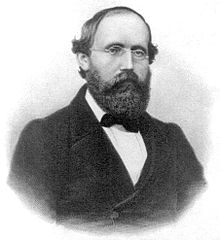Riemannian geometry
The Riemannian geometry is a branch of differential geometry and was named after Bernhard Riemann named. In this theory the geometrical properties of a Riemannian manifold are investigated. These are smooth manifolds with a kind of scalar product . This function can be used to measure angles, lengths, distances and volumes.
Emergence
The first work on differential geometry can be traced back to Carl Friedrich Gauß . He founded the theory of curved surfaces that were embedded in three-dimensional space. Riemann's geometry received its decisive impetus in 1854 in Riemann's habilitation lecture entitled "About the hypotheses on which geometry is based". In this work he introduced the Riemannian metrics, which were later named after him. In contrast to Gauss, he not only looked at surfaces, but also higher-dimensional, curved spaces. However, these rooms were still embedded in a Euclidean space . The abstract topological definition of differentiable and thus in particular of Riemannian manifolds was only developed by Hassler Whitney in the 1930s . The statement that every differentiable manifold can be embedded is particularly well known . This result is known today as the Whitney embedding theorem .
Riemann's ideas were further developed in the second half of the 19th century by Elwin Bruno Christoffel ( covariant derivative , Christoffelsymbole ) and in the context of the tensor calculus by Gregorio Ricci-Curbastro and Tullio Levi-Civita .
The theory received a boost from Albert Einstein's (1916) general theory of relativity , which is based on the pseudo-Riemannian manifolds . In this context, the theory was further developed in particular by Hermann Weyl and Élie Cartan , who emphasized the role of affine relationships and parallel transport .
Important objects and statements
The central object of Riemannian geometry is the Riemannian manifold. This is a smooth manifold together with a mapping that defines a scalar product of the tangent space at every point , that is, a positively definite , symmetric bilinear form
With the help of this Riemannian metric, the terms arc length , distance and angle are obtained as in usual vector spaces with a scalar product .
A mapping between Riemannian manifolds that contains the Riemannian metric (and thus also the lengths and angles of tangential vectors and the length of curves) is called Riemannian isometry . However, such a mapping does not need to contain the distance between points and is therefore generally not an isometric drawing in the sense of metric spaces.
Another object induced by the Riemannian metric is the Riemannian volume shape . This makes it possible to measure volumes on manifolds and is therefore a central component of integration theory on oriented Riemannian manifolds.
Since a distance is defined on ( connected ) Riemannian manifolds, the concept of completeness can also be transferred. The set of Hopf Rinow is central. Among other things, it states that the generalized (geodetic) completeness on the manifold is equivalent to the completeness as metric space. Another important statement is Nash's embedding theorem . Analogous to Whitney's embedding theorem , he says that any Riemannian manifold can be embedded in a sufficiently large dimension. However, compared to Whitney's embedding theorem, it makes a stronger statement, because it further states that the embedding is given lengths and angles. Embedding means here that the manifold can be understood as a subset of .
In addition to the metric properties, one is interested in Riemannian geometry for curvature quantities. In the theory of surfaces , the Gaussian curvature was investigated before Riemann's work . In the case of higher dimensional manifolds, the investigation of the curvature is more complex. For this purpose the Riemann curvature tensor was introduced. With the help of this tensor one defines the sectional curvature , this can be understood as a generalization of the Gaussian curvature and is the most important term of curvature in Riemannian geometry, which is used in particular in comparative theory . Linear relationships on vector bundles also play an important role in curvature theory, in particular for the definition of the Riemann curvature tensor. There is a clear linear relationship on Riemannian manifolds, which is torsion-free and compatible with the Riemannian metric . This statement is often referred to as the main theorem of Riemannian geometry . The corresponding connection is called the Levi-Civita connection .
Comparative theory
In Riemann's geometry there are some statements that are traditionally referred to as comparative theorems. With these statements, one examines, for example, Riemannian manifolds whose sectional curvature or Ricci curvature is limited upwards or downwards. For example, Bonnet's theorem makes a statement about manifolds, the curvature of which is bounded below by a positive number. A stronger statement is Myers ' theorem , which derives the same statement from the weaker condition of the Ricci curvature bounded downwards by a positive number . The Cartan-Hadamard theorem , however, shows a link between manifolds with non-negative sectional curvature and their universal overlay space on. One of the most important comparative theorems in Riemannian geometry is the theorem of spheres . This states that compact, simply connected , Riemannian manifolds , for whose sectional curvature the inequality applies, are homeomorphic to the sphere .
literature
- P. Petersen: Riemannian geometry , Second Edition, Springer-Verlag, 2006, ISBN 0-387-29403-1
- Manfredo Perdigão do Carmo: Riemannian Geometry , Birkhäuser, Boston 1992, ISBN 0-8176-3490-8
- Marcel Berger : A panoramic view of Riemannian geometry . Springer-Verlag, Berlin, 2003, ISBN 3-540-65317-1
- Sylvestre Gallot, Dominique Hulin, Jacques Lafontaine: Riemannian Geometry (Second Edition), Springer-Verlag, Berlin / Heidelberg 1990, ISBN 3-540-52401-0
- Martin Schottenloher: Geometry and Symmetry in Physics , vieweg textbook, 1995, ISBN 3-528-06565-6
- Torsten Fließbach : General Theory of Relativity , Spectrum Academic Publishing House, Heidelberg 2006, ISBN 3-8274-1356-7
- Siegfried Kästner: vectors, tensors, spinors , Akademie Verlag, Berlin 1964
Web links
- Bernhard Riemann: About the hypotheses on which geometry is based , inaugural lecture, topic proposed by Carl Friedrich Gauß








